Characteristics of Water Vapor Transport for Extreme Summer Precipitation in the Eastern Southwest China and Its Impact Mechanism
Abstract
:1. Introduction
2. Data and Methods
2.1. Data
2.2. Methods
3. Extreme Precipitation Changes and Atmospheric Circulation Features
3.1. Extreme Precipitation Characteristics in the ESWC
3.2. Characteristics of Associated Circulation
4. Characteristics of Water Vapor Transport during Extreme Precipitation
4.1. Water Vapor Budget
4.2. Source of Water Vapor
5. Driven Factors of Interannual Variability of Extreme Precipitation and Physical Conceptual Model
5.1. Relationship between the Number of Extreme Precipitation Days and the IOBW Index, Water Vapor Budget
5.2. Physical Concept Model of the Impact of Extreme Summer Precipitation
6. Conclusions and Discussion
Author Contributions
Funding
Institutional Review Board Statement
Informed Consent Statement
Data Availability Statement
Conflicts of Interest
References
- Sun, J.; Zhang, F. Daily extreme precipitation and trends over China. Sci. China Earth Sci. 2017, 60, 2190–2203. [Google Scholar] [CrossRef]
- Zhou, Y.; Liu, L.; Zhu, K.; Li, J. Simulation and evolution characteristics of mesoscale systems occurring in Beijing on 21 July 2012. Chin. J. Atmos. Sci. 2014, 38, 885–896. (In Chinese) [Google Scholar]
- Lei, L.; Sun, J.S.; He, N.; Liu, Z.; Zeng, J. A study on the mechanism for the vortex system evolution and development during the torrential rain event in North China on 20 July 2016. Acta Meteorol. Sin. 2017, 75, 658–699. (In Chinese) [Google Scholar]
- Sun, Y.; Xiao, H.; Yang, H.L.; Ding, J.; Fu, D.; Guo, X.; Feng, L. Analysis of dynamic conditions and hydrometeor transport of Zhengzhou superheavy rainfall event on 20 July 2021 based on optical flow field of remote sensing data. Chin. J. Atmos. Sci. 2021, 45, 1384–1399. (In Chinese) [Google Scholar]
- Ran, L.K.; Li, S.W.; Zhou, Y.S.; Yang, S.; Ma, S.; Zhou, K.; Shen, D.D.; Jiao, B.F.; Li, N. Observational Analysis of the Dynamic, Thermal, and Water Vapor Characteristics of the “7.20” Extreme Rainstorm Event in Henan Province, 2021. Chin. J. Atmos. Sci. 2021, 45, 1366–1383. (In Chinese) [Google Scholar]
- Chen, Y.; Chen, X.; Ren, G. Variation of extreme precipitation over large river basins in China. Adv. Clim. Chang. Res. 2010, 6, 265–269. [Google Scholar] [CrossRef]
- Seneviratne, S.I.; Nicholls, N.; Easterling, D.; Goodess, C.M.; Kanae, S.; Kossin, J.; Luo, Y.; Marengo, J.; McInnes, K.; Rahimi, M.; et al. Changes in climate extremes and their impacts on the natural physical environment. In Managing the Risks of Extreme Events and Disasters to Advance Climate Change Adaptation: A Special Report of Working Groups I and II of the Intergovernmental Panel on Climate Change; Field, C.B., Barros, V., Stocker, T.F., Qin, D., Dokken, D.J., Ebi, K.L., Mastrandrea, M.D., Mach, K.J., Plattner, G.K., Allen, et al., Eds.; Cambridge University Press: Cambridge, UK, 2012; pp. 109–230. [Google Scholar] [CrossRef]
- Ivancic, T.J.; Shaw, S.B. Examining why trends in very heavy precipitation should not be mistaken for trends in very high river discharge. Clim. Chang. 2015, 133, 681–693. [Google Scholar] [CrossRef]
- Wasko, C.; Nathan, R. Influence of changes in rainfall and soil moisture on trends in flooding. J. Hydrol. 2019, 575, 432–441. [Google Scholar] [CrossRef]
- Chen, Y.; Liao, Z.; Shi, Y.; Tian, Y.; Zhai, P. Detectable increases in sequential flood–heatwave events across china during 1961–2018. Geophys. Res. Lett. 2021, 48, e2021GL092549. [Google Scholar] [CrossRef]
- Lu, C.; Jiang, J.; Chen, R.; Ullah, S.; Yu, R.; Lott, F.C.; Tett, S.F.B.; Dong, B. Anthropogenic influence on 2019 May–June extremely low precipitation in southwestern China. Bull. Am. Meteorol. Soc. 2021, 102, S97–S102. [Google Scholar] [CrossRef]
- Jiang, J.; Zhou, T.; Zhang, W. Temporal and Spatial Variations of Extreme Precipitation in the Main River Basins of China in the Past 60 Years. Chin. J. Atmos. Sci. 2022, 46, 707–724. (In Chinese) [Google Scholar]
- Ma, S.; Zhou, T.; Stone, D.A.; Polson, D.; Dai, A.; Stott, P.A.; von Storch, H.; Qian, Y.; Burke, C.; Wu, P.; et al. Detectable anthropogenic shift toward heavy precipitation over eastern China. J. Clim. 2017, 30, 1381–1396. [Google Scholar] [CrossRef]
- He, B.; Zhai, P. Characteristics of the persistent and nonpersistent extreme precipitation in China from 1961 to 2016. Clim. Change Res. 2018, 14, 437–444. (In Chinese) [Google Scholar]
- Li, W.; Chen, Y. Detectability of the trend in precipitation characteristics over China from 1961 to 2017. Int. J. Climatol. 2021, 41, E1980–E1991. [Google Scholar] [CrossRef]
- Zhai, P.; Zhang, X.; Wan, H.; Pan, X. Trends in total precipitation and frequency of daily precipitation extremes over China. J. Clim. 2005, 18, 1096–1108. [Google Scholar] [CrossRef]
- Chen, H.; Fan, S.; Zhang, X. Seasonal differences of variation characteristics of extreme precipitation events over China in the last 50 years. Trans. Atmos. Sci. 2009, 32, 744–751. (In Chinese) [Google Scholar] [CrossRef]
- Ma, S.; Zhou, T.; Dai, A.; Han, Z. Observed changes in the distributions of daily precipitation frequency and amount over China from 1960 to 2013. J. Clim. 2015, 28, 6960–6978. [Google Scholar] [CrossRef]
- Zhou, B.; Xu, Y.; Wu, J.; Dong, S.; Shi, Y. Changes in temperature and precipitation extreme indices over China: Analysis of a highresolution grid dataset. Int. J. Climatol. 2016, 36, 1051–1066. [Google Scholar] [CrossRef]
- Wang, Y.; Zhou, B.; Qin, D.; Wu, J.; Gao, R.; Song, L. Changes in mean and extreme temperature and precipitation over the arid region of northwestern China: Observation and projection. Adv. Atmos. Sci. 2017, 34, 289–305. [Google Scholar] [CrossRef]
- Xie, Y.; Dai, W. Certain computational results of water vapor transport over eastern China for a selected synoptic case. Acta Meteor. Sin. 1959, 30, 173–185. (In Chinese) [Google Scholar] [CrossRef]
- Wang, X.; Ding, Y.; Zhang, Q. Circulation pattern and moisture transport for summertime persistent heavy precipitation in eastern China. Clim. Environ. Res. 2017, 22, 221–230. (In Chinese) [Google Scholar] [CrossRef]
- Ding, Y.; Liu, Y.; Song, Y. East Asian summer monsoon moisture transport belt and its impact on heavy rainfalls and floods in China. Adv. Water Sci. 2020, 31, 629–643. (In Chinese) [Google Scholar]
- Chen, B.; Xu, X.; Shi, X. Estimating the water vapor transport pathways and associated sources of water vapor for the extreme rainfall event over east of China in July 2007 using the Lagrangian method. Acta Meteorol. Sin. 2011, 69, 810–818. (In Chinese) [Google Scholar]
- Bueh, C.; Zhuge, A.R.; Xie, Z.W.; Gao, Z.; Lin, D. Water Vapor Transportation Features and Key Synoptic-scale Systems of the “7.20” Rainstorm in Henan Province in 2021. Chin. J. Atmos. Sci. 2022, 46, 725–744. (In Chinese) [Google Scholar] [CrossRef]
- Huang, Y.; Cui, X. Moisture sources of an extreme precipitation event in Sichuan, China, based on the Lagrangian method. Atmos. Sci. Lett. 2015, 16, 177–183. [Google Scholar] [CrossRef]
- Li, Y.; Jiang, X. Characteristics of water vapor transportation during summer heavy rainfall at the upper reaches of Yangtze River in 1998. Torrential Rain Disasters 2007, 26, 37–41. (In Chinese) [Google Scholar]
- Li, Y.; Xu, H.; Gao, Y.; Li, Q. The characteristics of moisture transport associated with drought/flood in summer over the east of the southwestern China. Acta Meteorol. Sin. 2010, 6, 932–943. (In Chinese) [Google Scholar] [CrossRef]
- Li, Y.; Zhou, J.; He, J.; Lu, C.; Xiang, B. Characteristics of Water Vapor Transport Associated with Abnormal Precipitation over the East of Southwestern China in June and July 2020. Chin. J. Atmos. Sci. 2022, 46, 309–326. (In Chinese) [Google Scholar]
- Qi, D.; Li, Y.; Zhou, C. Variation Characteristics of Summer Water Vapor Budget and Its Relationship with the Precipitation over the Sichuan Basin. Water 2021, 13, 2533. [Google Scholar] [CrossRef]
- Qi, D.; Li, Y.; Zhou, C.; Dan, C. Climatic Change of Summer Rainstroms and the Water Vapor Budget in the Sichuan Basin. J. Appl. Meteorol. Climatol. 2022, 61, 537–557. [Google Scholar] [CrossRef]
- Tang, H.; Gu, J.; Yu, S.; Zhang, H.; He, H. Analysis on diurnal variation of precipitation in Southwest China. Plateau Meteorol. 2011, 30, 376–384. (In Chinese) [Google Scholar]
- Ma, Z.; Li, Y.; Wu, Z.; Zhu, Y.; Du, J. Climate Change Assessment Report in Southwest China: 2020; Sichuan Nationalities Publishing House: Chengdu, China, 2021. (In Chinese) [Google Scholar]
- Peterson, T.; Folland, C.; Gruza, G.; Hogg, W.; Mokssit, A.; Plummer, N. Report on the Activities of the Working Group on Climate Change Detection and Related Rapporteurs; World Meteorological Organization: Geneva, Switzerland, 2001. [Google Scholar]
- Li, X.; Fan, K.; Xu, Z. Decrease in Extreme Precipitation in Summer over East Northern China and the Water-Vapor Transport Characteristics after Year 2000. Chin. J. Atmos. Sci. 2019, 43, 1109–1124. (In Chinese) [Google Scholar] [CrossRef]
- Wang, Y.Q.; Zhang, X.Y.; Draxler, R. TrajStat: GIS-based software that uses various trajectory statistical analysis methods to identify potential sources from long-term air pollution measurement data. Environ. Model. Softw. 2009, 24, 938–939. [Google Scholar] [CrossRef]
- Draxler, R.R.; Hess, G.D. An overview of the HYSPLIT_4 modeling system for trajectories, dispersion and deposition. Aust. Meteorol. Mag. 1998, 47, 295–308. [Google Scholar]
- Jiang, Z.; Liang, Z.; Liu, Z.; Zhu, Y. A diagnostic study of water vapor transport and budget during heavy precipitation over the Huaihe River Basin in 2007. Chin. J. Atmos. Sci. 2011, 35, 361–371. (In Chinese) [Google Scholar]
- Zhou, Y.; Yan, L.; Wu, T.; Xie, Z. Comparative analysis of two rainstorm processes in Sichuan Province affected by the Tibetan Plateau vortex and Southwest vortex. Chin. J. Atmos. Sci. 2019, 43, 813–830. (In Chinese) [Google Scholar] [CrossRef]
- Li, Y.; Huang, D.; Lu, C.; Xiang, B.; Zhou, J.; He, J. Moisture Sources and Their Contributions to Summer Precipitation in the East of Southwest China. J. Trop. Meteorol. 2023, 29, 153–167. [Google Scholar] [CrossRef]
- Hoskins, B.J.; Ambrizzi, T. Rossby wave propagation on a realistic longitudinally varying flow. J. Atmos. Sci. 1993, 50, 1661–1671. [Google Scholar] [CrossRef]
- Zhou, C.; Li, Y.; Li, W.; Chen, L. Climatological characteristics of water vapor transport over eastern part of Qinghai-Xizang Plateau and tts surroundings. Plateau Meteorol. 2005, 24, 880–888. (In Chinese) [Google Scholar]
- Zhou, C.; Jiang, X.W.; Li, Y.; Wei, G.C. Features of climate change of water vapor resource over eastern region of the Tibetan Plateau and its surroundings. Plateau Meteorol. 2009, 28, 55–63. (In Chinese) [Google Scholar]
- Zhou, C.; Li, Y.; Bu, Q.; Peng, J. Features of drought-flood coexistence in west and east of Sichuan-Chongqing Basin in midsummer and its relating background of atmospheric circulation. Plateau Meteorol. 2011, 30, 620–627. (In Chinese) [Google Scholar]
- Li, Y.; Lu, C.; Xu, H.; Cheng, B. Anomalies of sea surface temperature in Pacific-Indian Ocean and effects on drought/flood in summer over eastern of Southwest China. J. Trop. Meteorol. 2012, 28, 145–156. (In Chinese) [Google Scholar]
- Qiu, Y.; Cai, W.; Guo, X.; Ng, B. The asymmetric influence of the positive and negative IOD events on China’s rainfall. Sci. Rep. 2014, 4, 4943. [Google Scholar] [CrossRef] [PubMed]
- Ren, Q.; Zhou, C.; He, J.; Cen, S.; Deng, M. Impact of preceding Indian Ocean sea surface temperature anomaly on water vapor content over the Tibetan Plateau moist pool in summer and its possible reason. Chin. J. Atmos. Sci. 2017, 41, 648–658. (In Chinese) [Google Scholar] [CrossRef]
- Takaya, Y.; Ishikawa, I.; Kobayashi, C.; Endo, H.; Ose, T. Enhanced Meiyu-Baiu rainfall in early summer 2020: Aftermath of the 2019 super IOD event. Geophys. Res. Lett. 2020, 47, e2020GL090671. [Google Scholar] [CrossRef]
- Li, S.; Gong, Z.; Zhang, S.; Yang, J.; Qiao, S.; Feng, G. Decadal variation of the precipitation relationship between June and August over South China and its mechanism. Clim. Dyn. 2022, 59, 1863–1882. [Google Scholar] [CrossRef]
- Wu, G.; Liu, P.; Liu, Y.; Li, W. Impacts of the sea surface temperature anomaly in the Indian Ocean on the subtropical anticyclone over the western Pacific—Two-stage thermal adaptation in the atmosphere. Acta Meteorol. Sin. 2000, 58, 513–522. (In Chinese) [Google Scholar] [CrossRef]
- Matsuno, T. Quasi-geostrophic motion in the equatorial area. J. Meteor. Soc. Jpn. 1966, 44, 25–43. [Google Scholar] [CrossRef]
- Gill, A.E. Some simple solutions for heat-induced tropical circulation. Q. J. R. Meteorol. Soc. 1980, 106, 447–462. [Google Scholar] [CrossRef]
- Wu, B.; Zhou, T.J.; Li, T. Seasonally evolving dominant interannual variability modes of East Asian climate. J. Clim. 2009, 22, 2992–3005. [Google Scholar] [CrossRef]
- Wu, B.; Li, T.; Zhou, T.J. Relative contributions of the Indian Ocean and local SST anomalies to the maintenance of the western North Pacific anomalous anticyclone during the El Niño decaying summer. J. Clim. 2010, 23, 2974–2986. [Google Scholar] [CrossRef]
- Huang, G.; Hu, K.; Qu, X.; Tao, W.C.; Yao, S.L.; Zhao, G.J.; Jiang, W.P. A review about Indian Ocean basin mode and its impacts on East Asian summer climate. Chin. J. Atmos. Sci. 2016, 40, 121–130. (In Chinese) [Google Scholar] [CrossRef]
- Sun, B.; Wang, H.; Zhou, B.; Li, H.; Zhu, B. A review on the interannual and interdecadal variations of water vapor transport over China during past decades. Adv. Water Sci. 2020, 31, 644–653. (In Chinese) [Google Scholar]
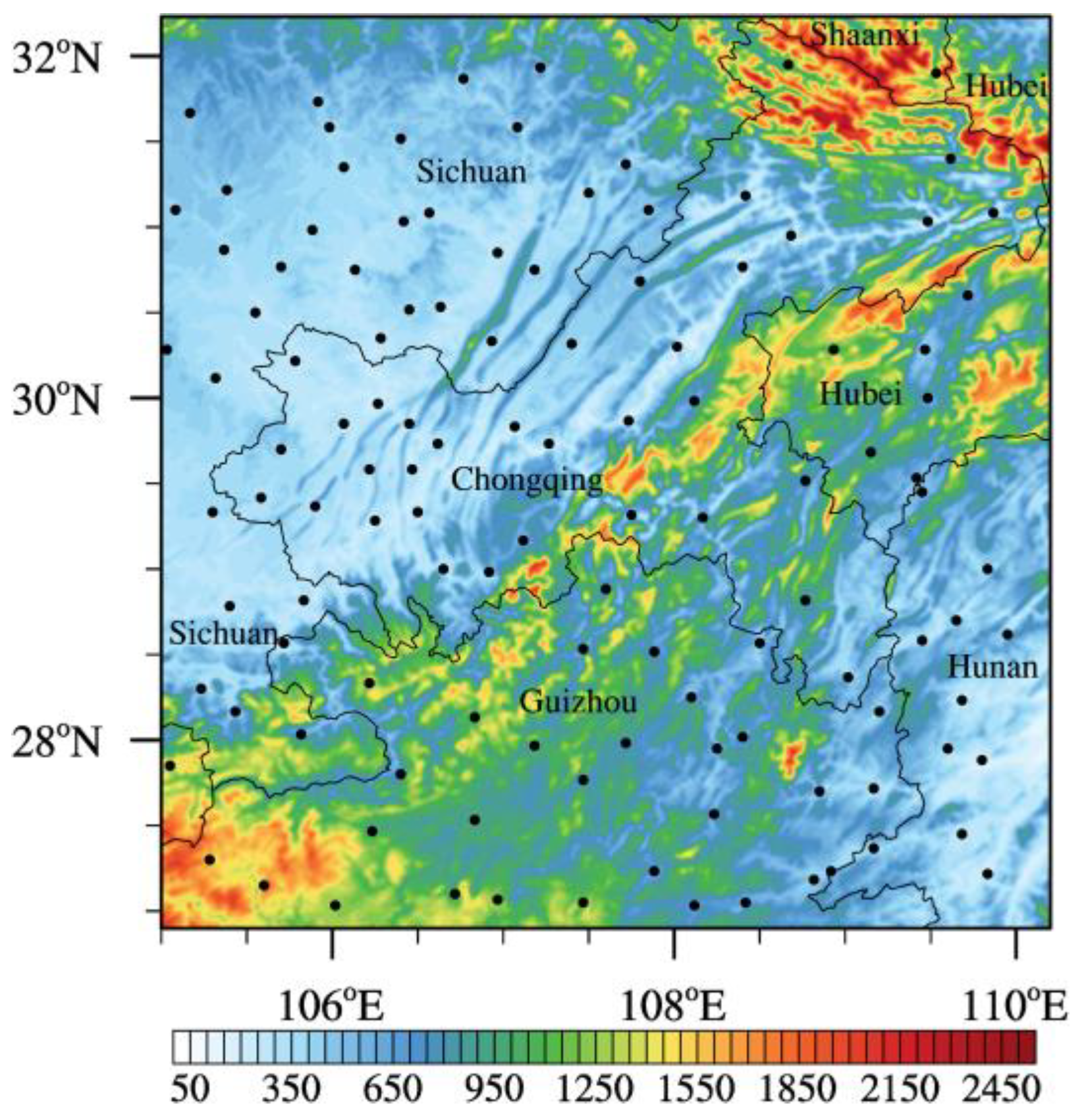
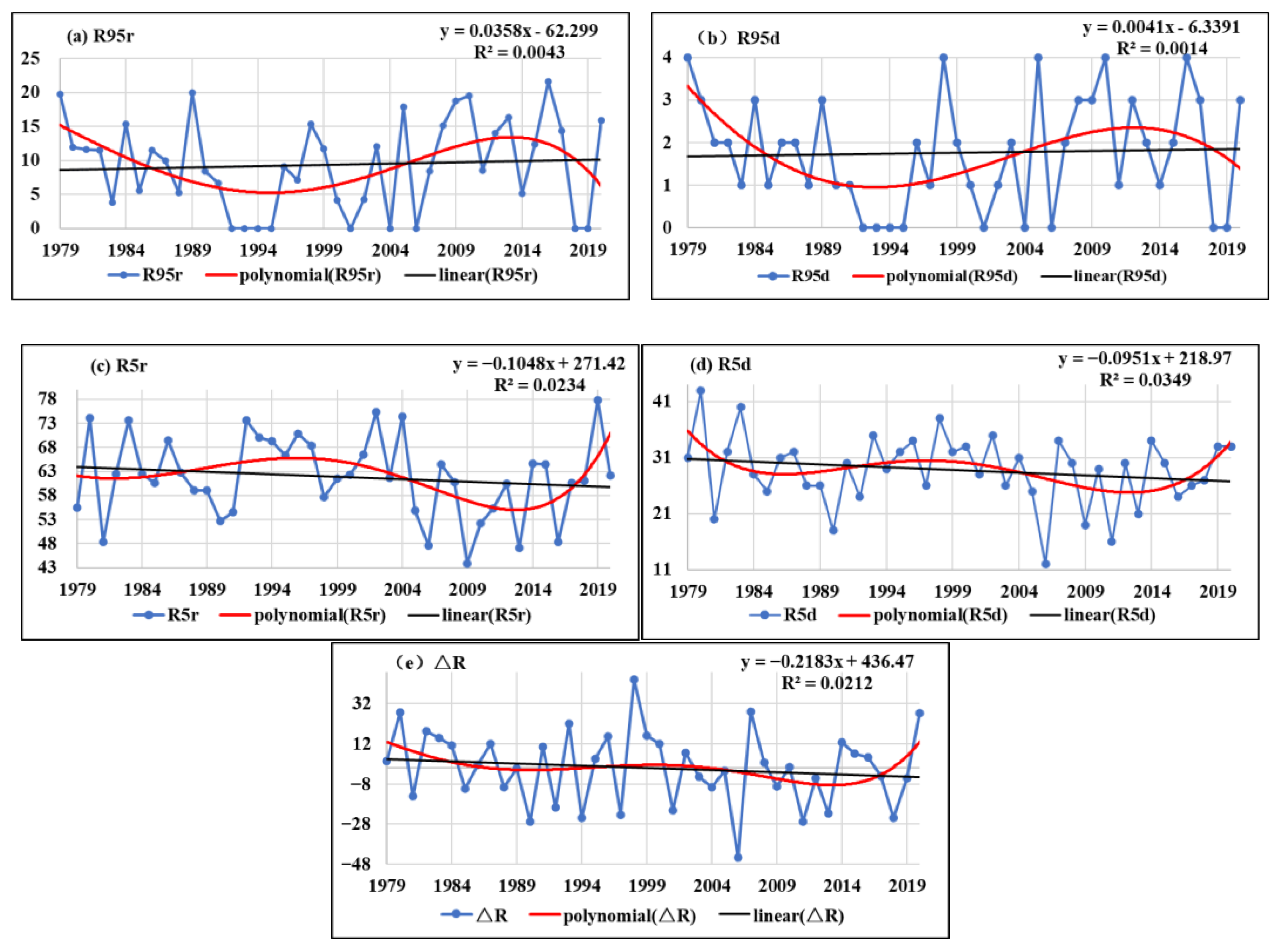
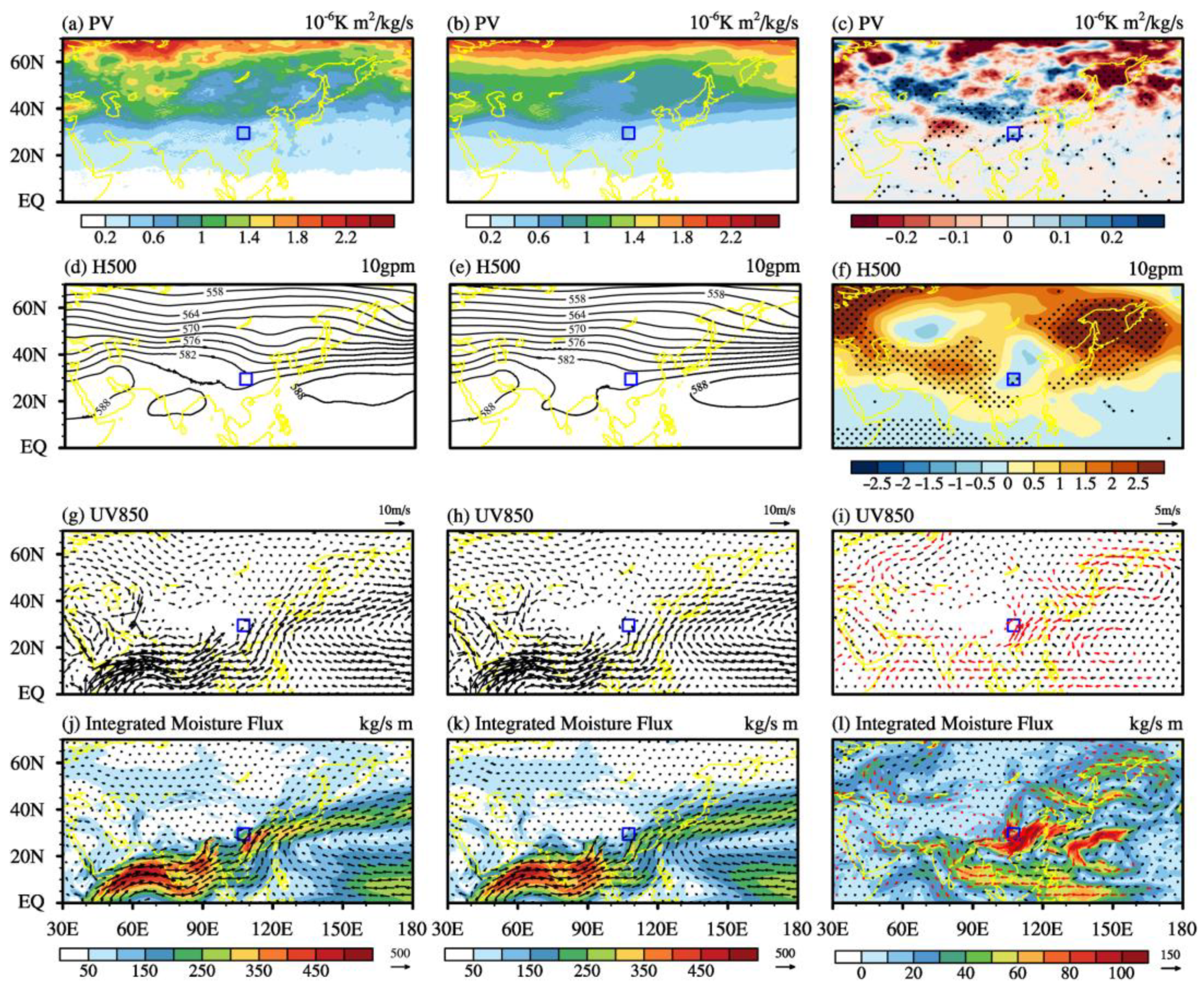
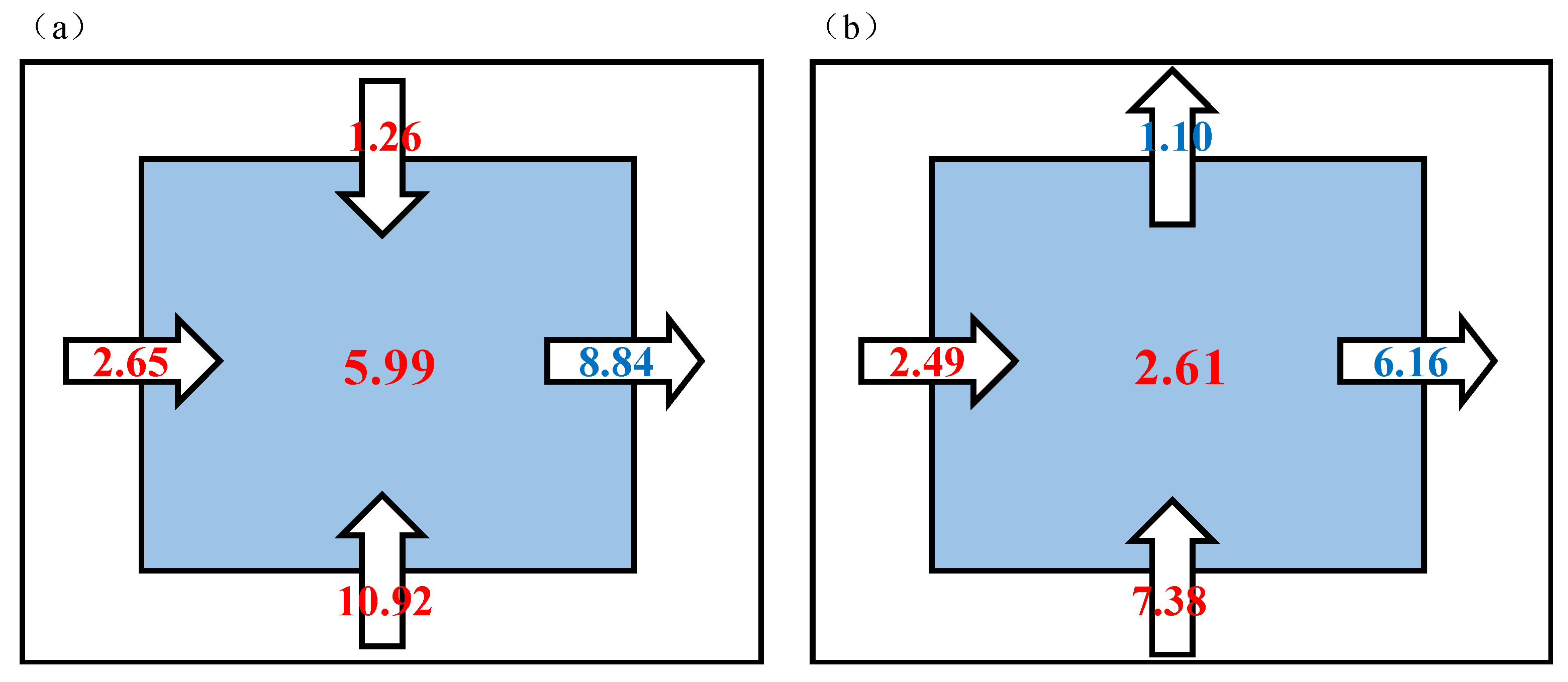
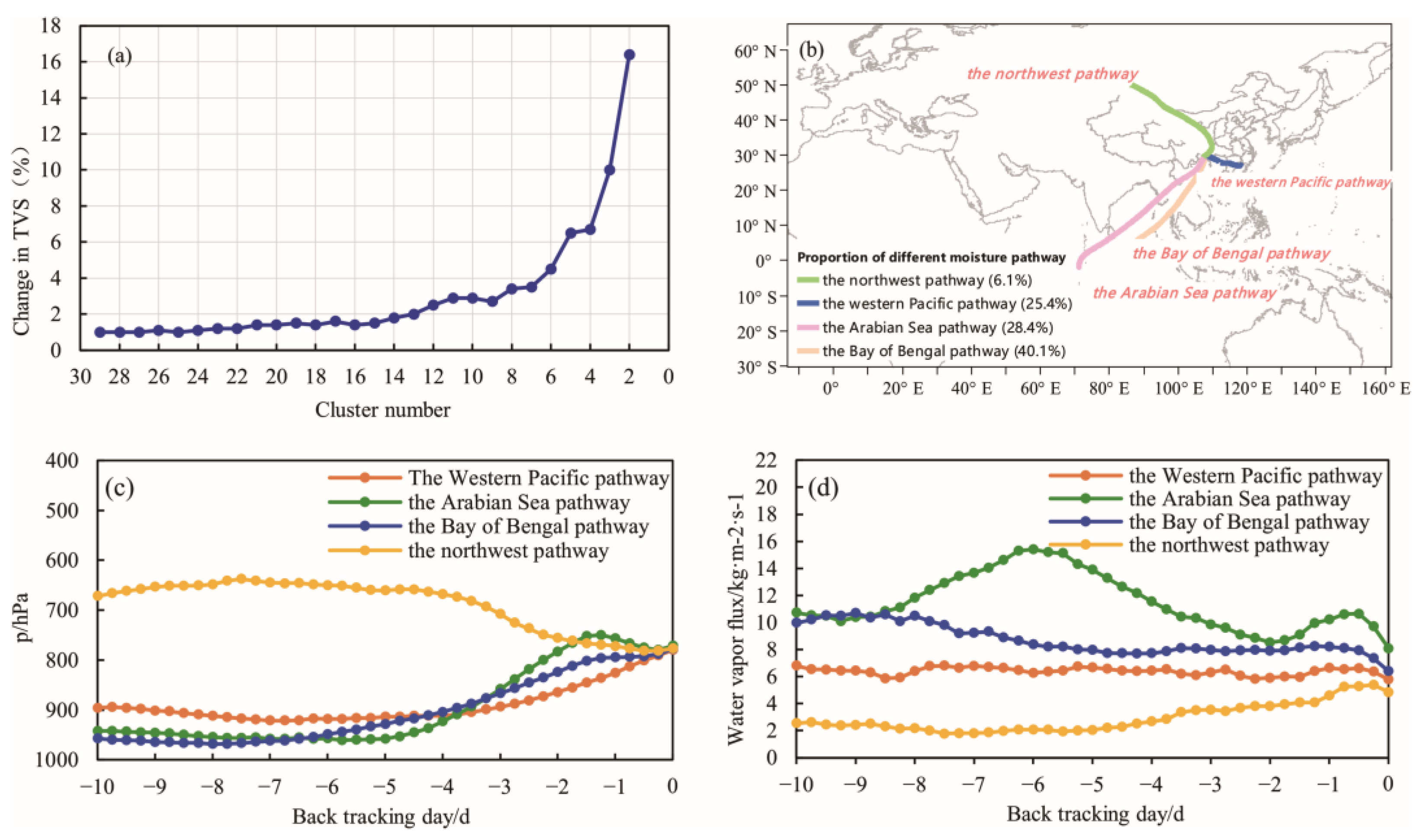
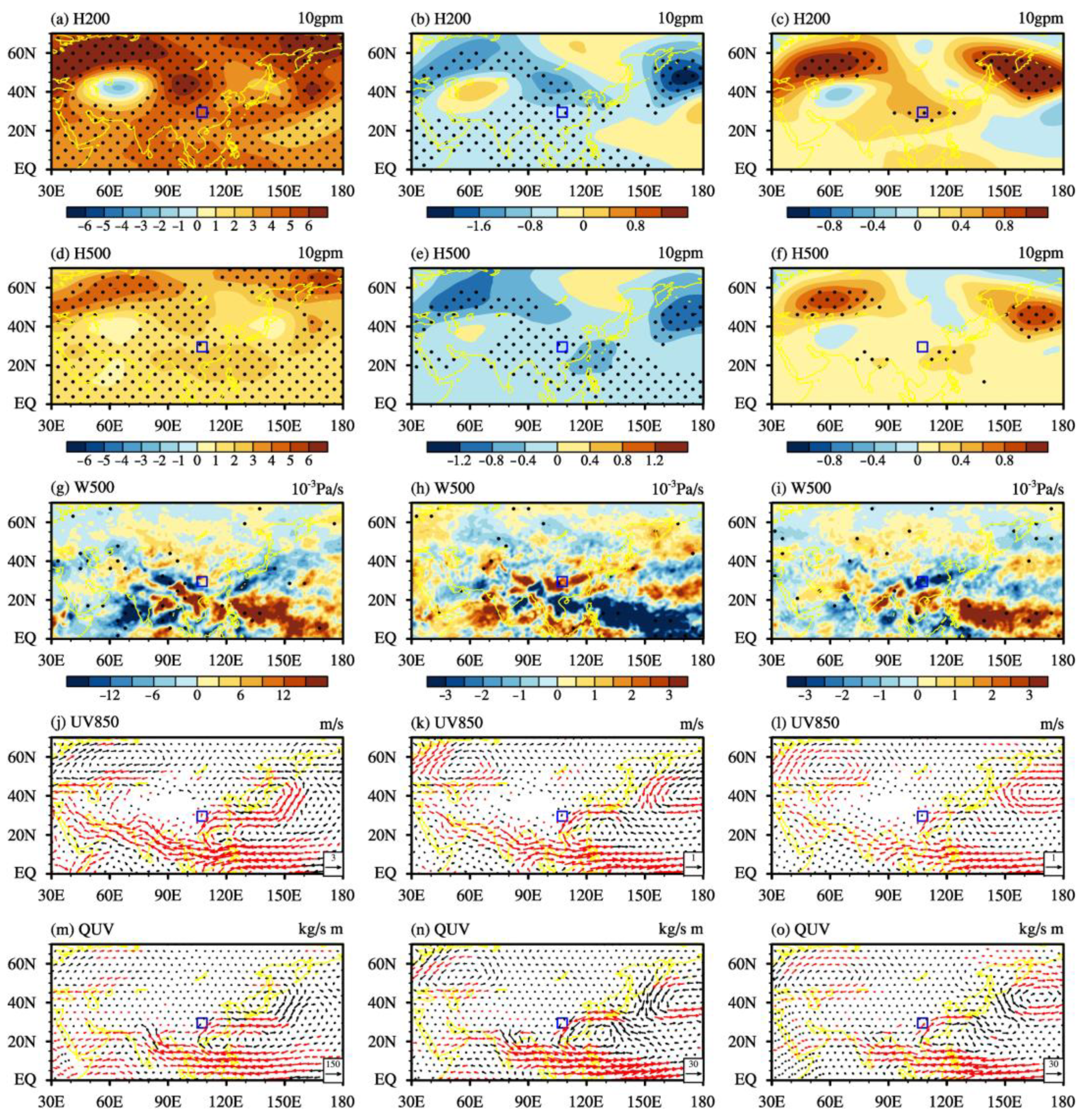
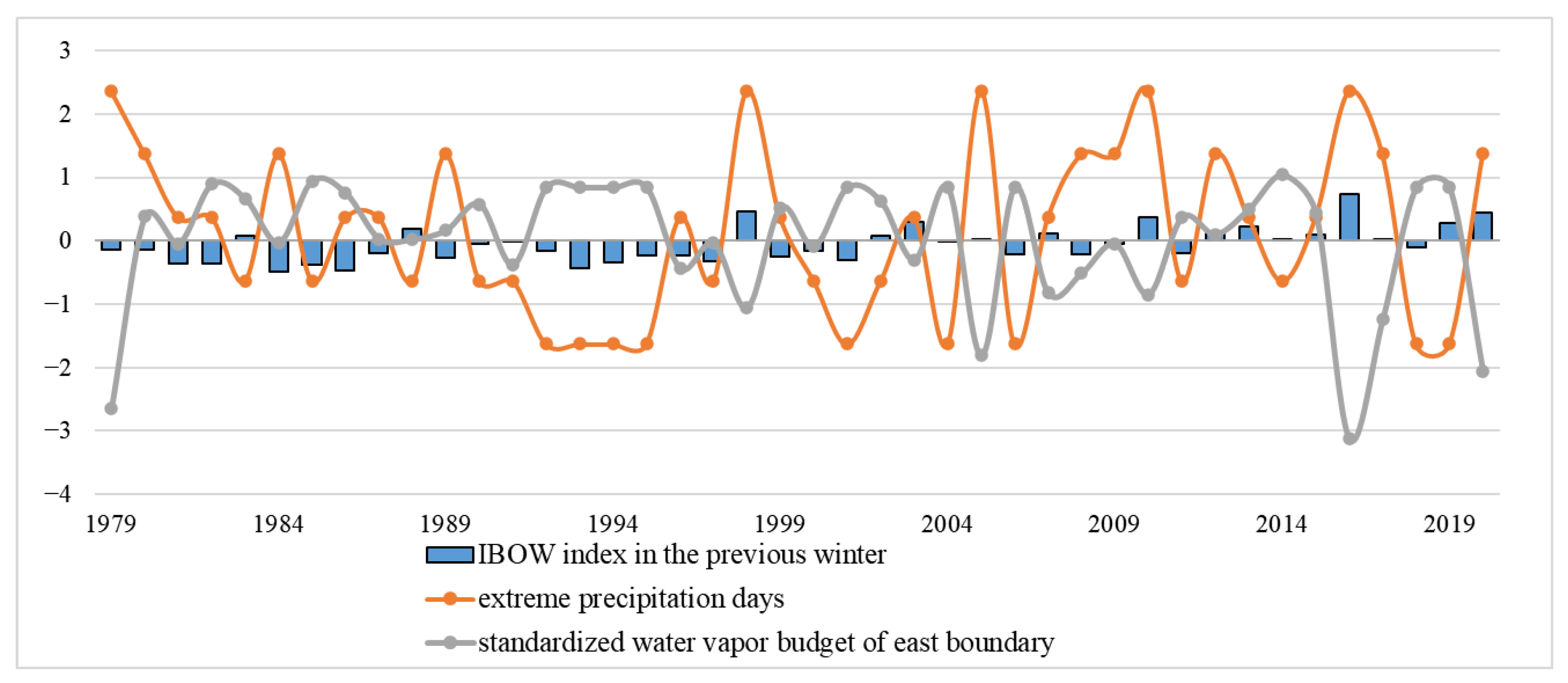
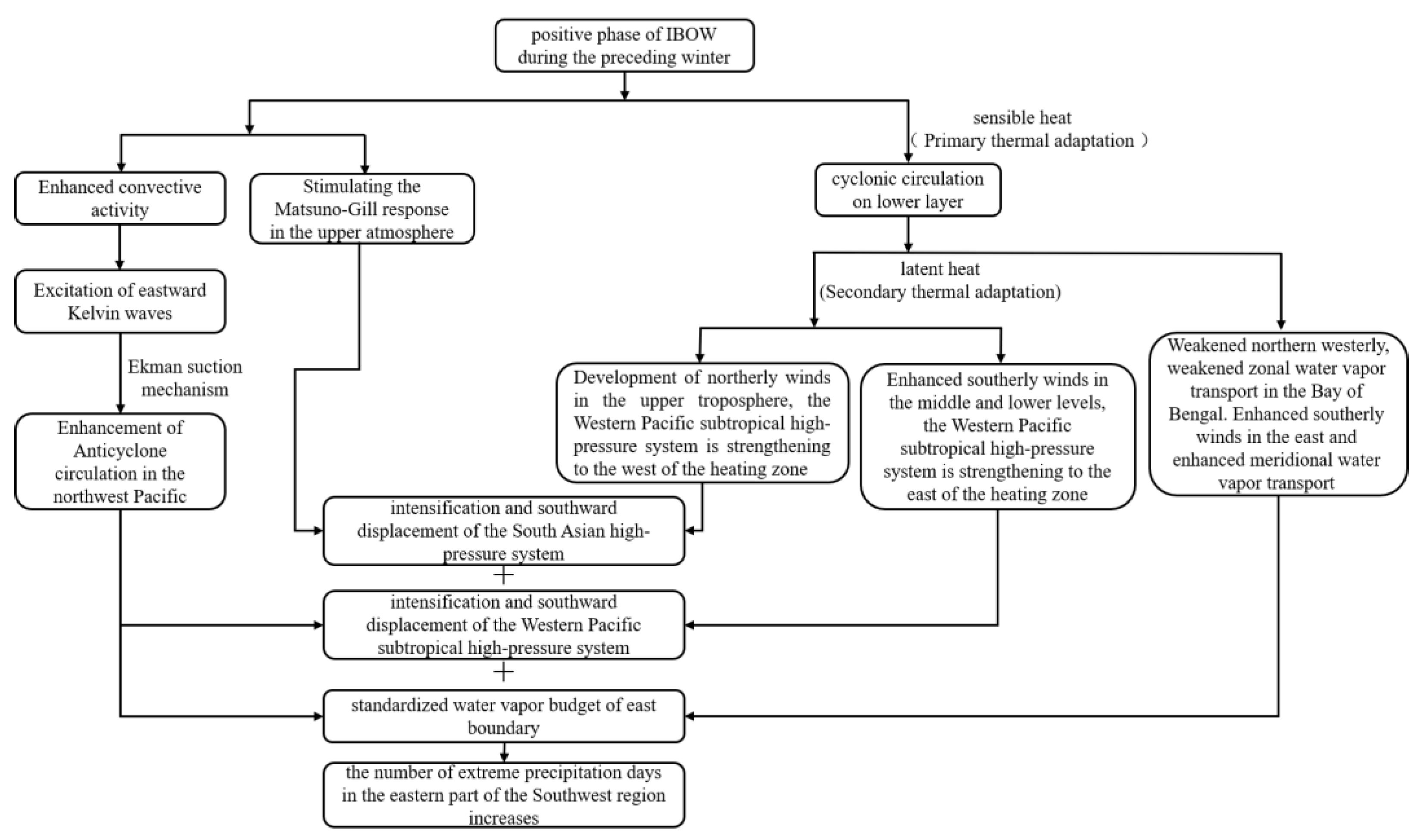
| R95d | R5r | R5d | △R | |
|---|---|---|---|---|
| R95r | 0.96 *** | −0.55 *** | −0.09 | 0.30 * |
| R95d | 1.00 | −0.44 *** | 0.09 | 0.44 ** |
| R95r | R95d | |
|---|---|---|
| East boundary | −0.44 *** | −0.46 *** |
| South boundary | 0.45 *** | 0.44 *** |
| West boundary | 0.34 ** | 0.32 ** |
| North boundary | 0.11 | 0.11 |
| Total water vapor budget | 0.46 *** | 0.40 *** |
| Physical Quantity | Bay of Bengal | Arabian Sea | Western Pacific | Northwest |
|---|---|---|---|---|
| Total number of trajectories/tracks | 40.1 | 28.4 | 25.4 | 6.1 |
| Specific humidity contribution rate/% | 42.12 | 30.13 | 23.09 | 4.66 |
| Moisture flux contribution rate/% | 38.88 | 34.82 | 21.91 | 4.39 |
| Potential pseudo-equivalent temperature/K | 349.59 | 351.48 | 337.78 | 330.98 |
| R95d | East Boundary | South Boundary | West Boundary | North Boundary | |
|---|---|---|---|---|---|
| IOBW | 0.37 ** | −0.53 *** | 0.43 *** | 0.38 ** | 0.14 |
Disclaimer/Publisher’s Note: The statements, opinions and data contained in all publications are solely those of the individual author(s) and contributor(s) and not of MDPI and/or the editor(s). MDPI and/or the editor(s) disclaim responsibility for any injury to people or property resulting from any ideas, methods, instructions or products referred to in the content. |
© 2023 by the authors. Licensee MDPI, Basel, Switzerland. This article is an open access article distributed under the terms and conditions of the Creative Commons Attribution (CC BY) license (https://creativecommons.org/licenses/by/4.0/).
Share and Cite
Li, Y.; Wu, Y.; Zhou, J.; Xiang, B.; He, J.; Huang, D. Characteristics of Water Vapor Transport for Extreme Summer Precipitation in the Eastern Southwest China and Its Impact Mechanism. Atmosphere 2023, 14, 1328. https://doi.org/10.3390/atmos14091328
Li Y, Wu Y, Zhou J, Xiang B, He J, Huang D. Characteristics of Water Vapor Transport for Extreme Summer Precipitation in the Eastern Southwest China and Its Impact Mechanism. Atmosphere. 2023; 14(9):1328. https://doi.org/10.3390/atmos14091328
Chicago/Turabian StyleLi, Yonghua, Yao Wu, Jie Zhou, Bo Xiang, Juanxiong He, and Dingan Huang. 2023. "Characteristics of Water Vapor Transport for Extreme Summer Precipitation in the Eastern Southwest China and Its Impact Mechanism" Atmosphere 14, no. 9: 1328. https://doi.org/10.3390/atmos14091328
APA StyleLi, Y., Wu, Y., Zhou, J., Xiang, B., He, J., & Huang, D. (2023). Characteristics of Water Vapor Transport for Extreme Summer Precipitation in the Eastern Southwest China and Its Impact Mechanism. Atmosphere, 14(9), 1328. https://doi.org/10.3390/atmos14091328





